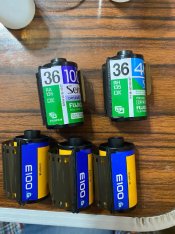mohmad khatab
Member
Hello my dear colleagues. Greetings to all .
Please help me understand this.
These films will be distributed to some new amateur youth during a filming tour that I will supervise in Al-Ahram in order to train the new youth.
I found a large amount of films in a large and old laboratory in Cairo, and this was for a laboratory specialized only in developing Positive films, which had huge machines and so on.
And of course he has some of his Positive Films stock from the 80s, in a hot and poorly stocked place,
But unfortunately, I tried a lot to shoot those films on the basis that they were positiv and I made attempts to develop them (E6), but unfortunately we did not get any result at all,
- I only developed one roll (C41) and the results were not good in strange colors,
- Conclusion :
I want to use these films as black and white films.
I want some advice on this.
Four ISO 100 films and there is only one 400
Do I consider all of them ISO 25 or what.?
- Regarding development
I was thinking of using Rodinal,
Does anyone have an idea of the time and percentage of dilution that will go with this coin.?
I was thinking of developing some Agfascala films but I am not sure this old emulsion might not withstand this process.
I'm reall
We have these rolls that are expired since the year 80.. We want to produce a black and white image from those films. How do we photograph it? How do we develop it?
y a little confused
I thank you all in advance,
Please help me understand this.
These films will be distributed to some new amateur youth during a filming tour that I will supervise in Al-Ahram in order to train the new youth.
I found a large amount of films in a large and old laboratory in Cairo, and this was for a laboratory specialized only in developing Positive films, which had huge machines and so on.
And of course he has some of his Positive Films stock from the 80s, in a hot and poorly stocked place,
But unfortunately, I tried a lot to shoot those films on the basis that they were positiv and I made attempts to develop them (E6), but unfortunately we did not get any result at all,
- I only developed one roll (C41) and the results were not good in strange colors,
- Conclusion :
I want to use these films as black and white films.
I want some advice on this.
Four ISO 100 films and there is only one 400
Do I consider all of them ISO 25 or what.?
- Regarding development
I was thinking of using Rodinal,
Does anyone have an idea of the time and percentage of dilution that will go with this coin.?
I was thinking of developing some Agfascala films but I am not sure this old emulsion might not withstand this process.
I'm reall
We have these rolls that are expired since the year 80.. We want to produce a black and white image from those films. How do we photograph it? How do we develop it?
y a little confused
I thank you all in advance,
Attachments
Last edited:











